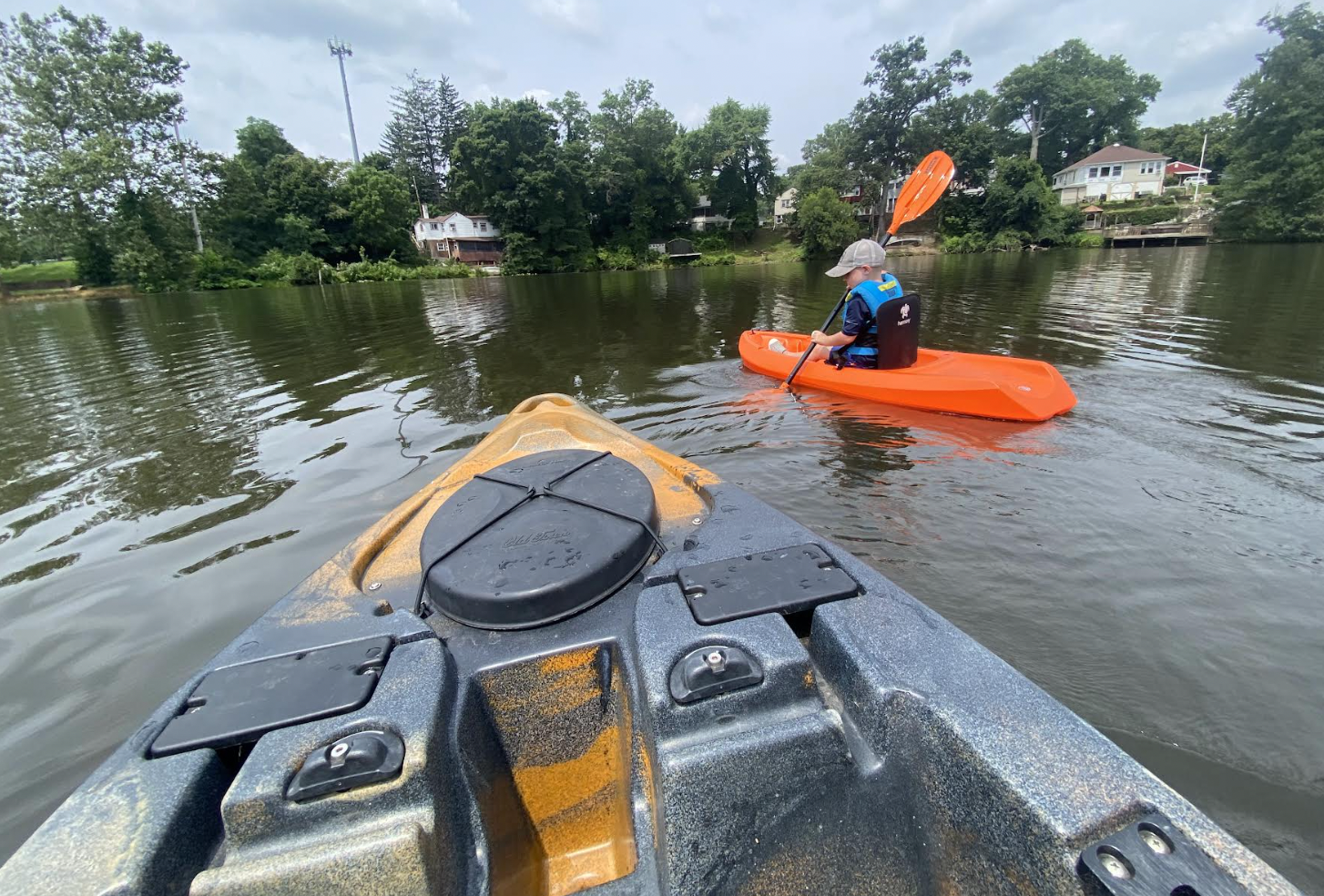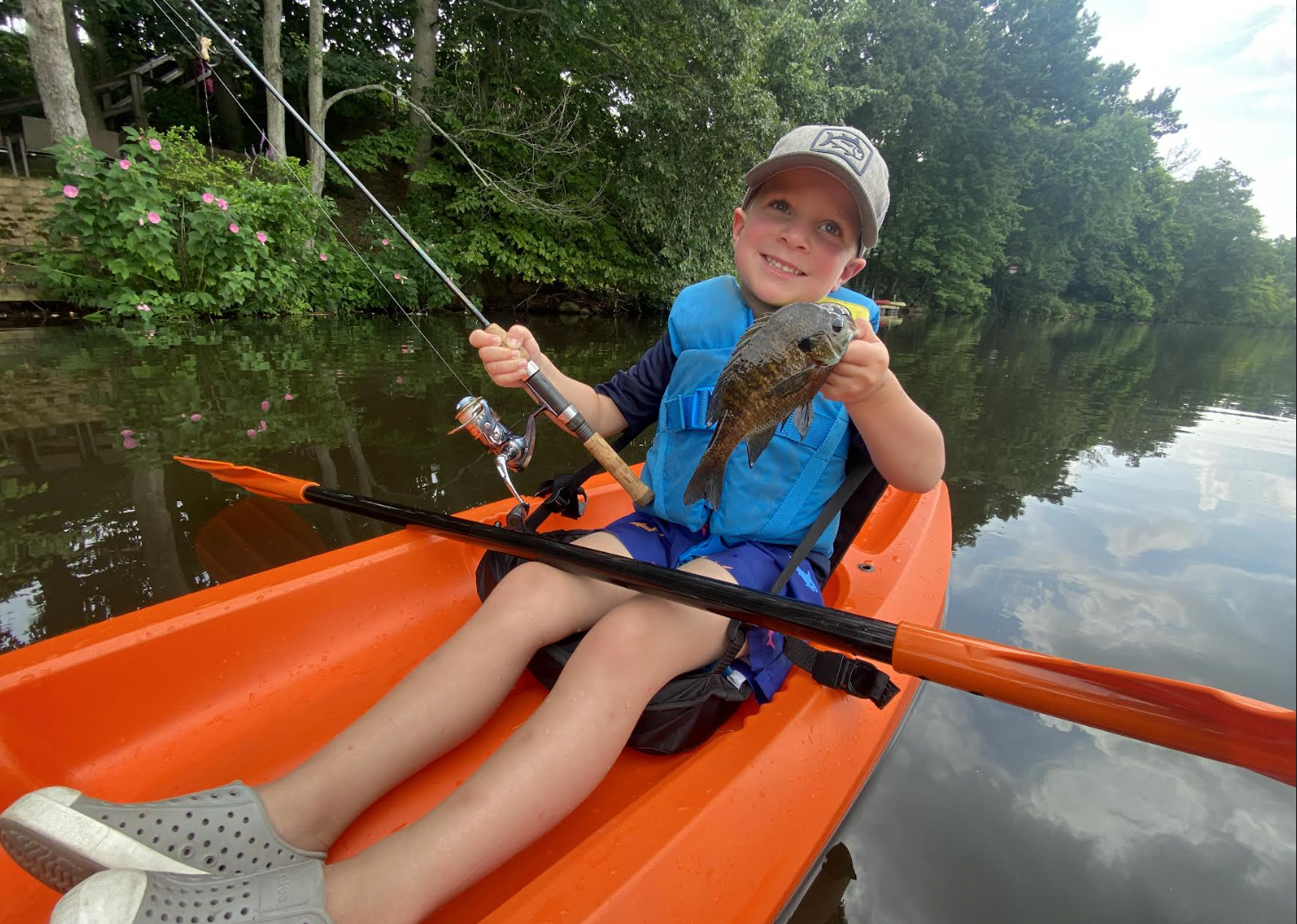We may earn revenue from the products available on this page and participate in affiliate programs. Learn More ›
Have you ever noticed those bright and shiny kids’ kayaks stacked up outside of Walmart during warmer months? I bought one for my son, Jamie, when he turned five last year. They’re so inexpensive that I didn’t mind if it got a little beat up on the lawn while he was using it to pretend fish, but I also knew he’d want to get it on the water. Since the age of three he’d been marveling at and crawling all over daddy’s Old Town Bigwater in the garage. When you’re five and weigh less that 50 pounds, these simple, sit-on-top kids’ kayaks are a great option, and despite the low price, they’re stable enough for your youngster to learn on.
However, before I ever attempted taking him fishing via kayak, we started out with just some simple paddling lessons on a local lake, which I highly recommend before involving hooks and lines. Since then, we’ve been on many kayak fishing adventures together and now at age six, Jamie is thrilled to be out there on “his own boat.”
As our journey progressed, I started getting a lot of questions from moms and dads with kids the same age. They were seeking advice on introducing their own children to kayak fishing. While I’ve only been at this with Jamie for two years now, I can share a few pointers that I guarantee will make the experience safer and a lot more fun.
Take It Slow and Steady

No matter what, don’t put a kid on a kayak in a precarious situation. Years from now, you might be surf launching together or tooling around on a fast river, but when starting out you want zero current. Furthermore, I will only take my son on days when the forecast is showing little to no wind. For an adult, even a 10- to 12-mph sustained breeze is no problem to paddle against, but if your kid is getting blown across the pond and struggling to maneuver, this can cause frustration at best or panic at worst. And panic and frustration lead to sudden movements and over-paddling which can lead to a kid in the water in a blink.
At my son’s current age, I have yet to take him kayak fishing during a season when he we wouldn’t be able to laugh off an accidental dunking—read that “only in summer when the air and water are both warm.” He’s a proficient swimmer, which I’d recommend your child be before they start paddling. Still, the goal with kayak fishing (and all fishing with kids, for that matter) is creating a positive experience so they want to go again. It takes far less to rattle a child than it does an adult, so everything we do when kayak fishing is done slowly. I don’t even bring the peddle drive on my kayak, opting to only paddle so Jamie and I are keeping a similar pace. We don’t race each other. We don’t pick a spot at the farthest corner of the lake. I go out of my way to make sure we’re at a location with an easy launch where we’ll find plenty of bluegills very close to the truck. Still, I always stash a 10-foot rope on my rig. I haven’t needed to use to yet, but just in case he needs to be towed back, I’m ready.
You Be the Mule
When Jamie and I shove off, I want nothing on his kayak but him and his paddle. Believe me, he wants to have his little tackle box, rod, and worms on his boat, but that can be a recipe for disaster. If he happened to roll his kayak, it’s all gone, because kayaks designed for little kids rarely have the secure storage and tethers that come standard on adult models. So I opt to be the dedicated gear (and snack and drink) hauler because kids get lost in their own world. They simply don’t pay attention like grownups, and it’s inevitable that he’ll accidently knock something into the water. If he tries to grab it quickly, he could go in. Even if he doesn’t, there will likely be crying, and the day could be over.
Tie Your Kayaks Together
Jamie is a very proficient caster for his age. He’s perfectly capable of baiting his own hooks and even unhooking his own fish. But that’s on dry land. Anyone who’s ever kayak fished knows that by nature, the process requires more thought and coordination when you’re doing it with little more than a sliver of plastic between you and the drink. That sliver, by the way, is not always stable. So, when I fish with Jamie, we have a system.
To help him get better and more confident with his paddling, I let him move from location to location on his own while I follow closely behind. Once he picks a spot he likes, however, I roll up alongside him and tether our kayakers together. You can do this with whatever you want, but I like a short bungee cord with carabiners on both ends because I can quickly clip him to my boat and unclip him when we’re ready to move.
Once we’re tethered together, I’ll stow his paddle on my ’yak and now I’m in control of both of us, gently using my paddle to keep us in place. He no longer has to be concerned about anything but casting and catching. I do all the baiting and hand over the rod.
As he gets older and into a bigger, more stable kayak, my plan is to slowly increase his independence, but for now the system works, and he walks away from every kayak adventure feeling proud and accomplished. And that, after all, is the point.

